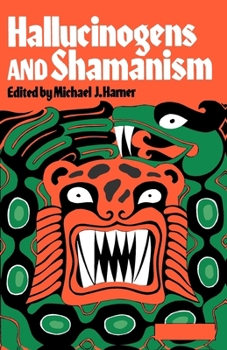Hallucinogens and Shamanism
Select Format
Select Condition 
Book Overview
224 pages. This description may be from another edition of this product.
Format:Paperback
Language:English
ISBN:0195016491
ISBN13:9780195016499
Release Date:May 1973
Publisher:Oxford University Press
Length:224 Pages
Weight:0.46 lbs.
Dimensions:0.5" x 5.5" x 7.9"
Customer Reviews
3 ratings
One of the few excellent sources for this subject
Published by Thriftbooks.com User , 18 years ago
It is high time (ahem) this collection of writings receive the praise it is due. Offerings on this subject have proliferated in recent decades, but far too many of them have little to offer those seeking genuine knowledge and understanding. Here, packed in one volume, is an assortment of excellent articles exploring various aspects of how hallucinogenic plants and fungi figure in ritual uses across culture. This is a work of anthropology, not lightweight stuff for those who want to beat their own drum playing "New Age shaman" (instead of learn about shamanism as an aspect of other cultures to which such practices actually belong). Later in his career, Harner abandoned this type of scholarly work and went with a more commercialized route that was far less interesting (unless, again, you want to become a Harner Core Method ® Shaman yourself). But this volume amply testifies that in his early career Harner did some excellent work, such as his field studies among the Shuar Indians (popularly known as the Jivaro), whose culture is steeped in shamanism and applications of hallucinogenic plants. (Incidental irony: many of the Shuar shamans state that they took up their practice in order to get rich!) One of the most fascinating and informative pieces in this book is Harner's article on the use of belladonna and related plants by peasant herbalists accused of witchcraft in mediaeval Europe. The evidence he presents is strong and persuasive, but watch out! It tends to demolish more fashionable and ideologically polarizing interpretations of history, such as (a) there were no "witches," the very idea is preposterous, the whole notion just a paranoid projection from the hysterical imaginations of superstitious people in a pre-scientific age; (b) witches were real, and Evil!, worshippers of Satan, even if they didn't exactly fly on broomsticks; and (c) witches were real and Good!, noble practitioners of an ancient pagan goddess-worship religion. No, its all much more interesting than any of that, turns out. The selections in this volume are generally well written, although in the scholarly-academic sense, i.e., with the intention of informing, not merely entertaining, the reader. A favorite, unique highlight herein is "The Mushrooms of Language," which astutely interprets Mazatec Indian customs concerning psilocybin mushrooms. The final section of the book raises an interesting question, of the extent to which experiences with hallucinogenic drugs may tap into something beyond cultural soft-wiring of perception, although none of the evidence offered could be described as conclusive, only suggestive. This book came out in the early 1970's, before the discussion and exploration of this subject got derailed by the "Castaneda effect" and similar "New Agey" influences. It is founded not upon exploitation and sensationalism, but intellectually open-minded curiosity and a desire to explore and learn with feet planted firmly on the ground. "Hall
Good topics, drab writing
Published by Thriftbooks.com User , 24 years ago
Despite the fact that I am absolutly facinated with Shamanism (more so Ethnobotany than the new age stuff) I found this work to be more of a textbook in the school sense and at times really dragged on. I do recommend this work for the content. Getting through the content can be a little arduous though
Entheogens: Professional Listing
Published by Thriftbooks.com User , 25 years ago
"Hallucinogens and Shamanism" has been selected for listing in "Religion and Psychoactive Sacraments: An Entheogen Chrestomathy" http://www.csp.org/chrestomathy






